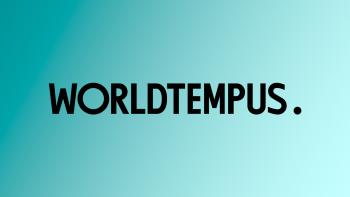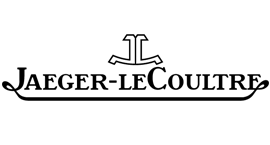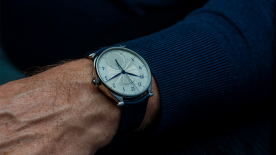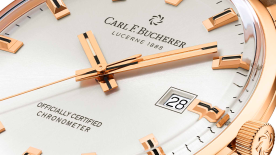Press release
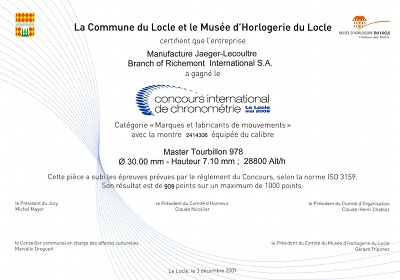
The Chronometrie 2009 international timing competition for mechanical wristwatches was held to mark the 50th anniversary of the watch museum in Le Locle. This watchmaking town in Canton Neuchâtel, Switzerland, was known in the pre-quartz-watch era for its chronometers. It was the first timing competition since the Neuchâtel observatory held the last trial in 1972. A total of 16 watches entered the competition and six were eliminated during the 45 days of timing trials held at Switzerland's chronometer-testing institute, COSC, in Biel and at the Besançon observatory in neighbouring France.
The results of the competition, kept secret since it ended in October, were announced at a ceremony at the museum on December 3, 2009. The prize for the best performing watch submitted by an independent watchmaker was awarded to Mr René Addor, whose watch gained 795 points, coming seventh overall. Unlike the previous competitions held at observatories from the late 19th century to 1972, Chronometrie 2009 included reliability tests in which the watches were subjected to the shocks and magnetic fields of daily wear.
The timing trials, according to the ISO 3159 international chronometer norms, were divided into three 15-day sessions, starting in Besançon, then at COSC and once more at COSC after the shock and magnetism tests. The watches were tested cased-up; the usual COSC chronometer certification tests only the basic movement. The revival of competitive timing also brings back the craft of the régleur, or precision timer who prepares watches for the contest. The art consists of juggling conflicting parameters to achieve the truest time and the most constant rate in different positions and temperatures. The two Jaeger-LeCoultre watches were adjusted by a team led by the firm's technical director, Mr Jean-Claude Meylan.
The timing results of the competition show that the Master Tourbillon gained on average 0.13 seconds a day, or less than 47.5 seconds a year, and its rate did not vary more than 0.28 seconds a day. The multi-axis Gyrotourbillon movement with a helical mainspring showed remarkable constancy of rate between vertical and horizontal positions, with an average daily variation of 0.29 seconds in the three stages of the trial. Jaeger-LeCoultre has kept alive precision timing skills with the 1000 Hours Control introduced in 1992, which tests the timekeeping performance and reliability of its watches in conditions of daily wear.
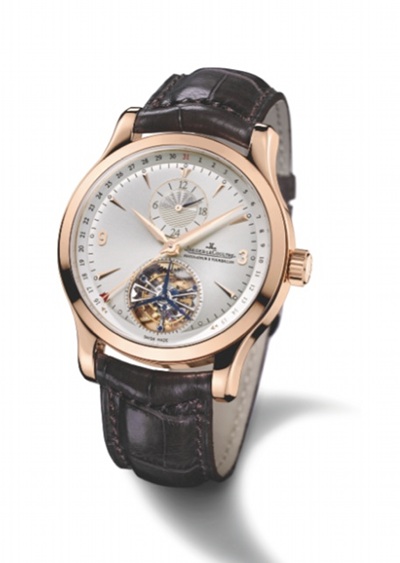
The results vindicate the introduction in 2009 of a new quality label, the 1000 Hours Chrono, which applies the ISO 3159 chronometer norms and focuses on precision timekeeping. “Since it was founded in 1833, the Jaeger-LeCoultre watch manufacturing company has been distinguished by the technical and aesthetic excellence of its timepieces,” notes the firm's CEO, Mr Jérôme Lambert. “The long process of innovation centred on precision and invention could only have been achieved by bringing together new skills and technologies under the same roof. This has made Jaeger-LeCoultre the reference as a complete and totally integrated watch manufacturer.”
The Chronometrie 2009 competition reflects a renewal of interest in mechanical precision, and has successfully adapted the traditional 45-day observatory trial to modern testing methods and the requirements of today's wristwatch owners. A second competition is scheduled for 2011.The competition jury was chaired by Professor Michel Mayor, discoverer of extra-solar planets and astrophysician at the Geneva Observatory where the first chronometer testing process was developed in 1879. An honorary committee, headed by Swiss astronaut, Professor Claude Nicolier of the federal technical school in Lausanne (EPFL), ensured the integrity of the result. Mr Claude-Henri Chabloz of the Le Locle museum presided over the organising committee, which included representatives of the Swiss Society for Chronometry, COSC, the Besançon observatory and the ARC technical high school in Le Locle.
